Abstract
Understanding the formation mechanisms of three-phase products during biomass pyrolysis is essential for optimizing thermochemical conversion and enhancing the efficient utilization of renewable resources. In this study, wheat straw (WS) and pine sawdust (PS) were selected as representative feedstocks to investigate the thermal decomposition behavior and evolution characteristics of gas, liquid (tar), and solid (char) products during pyrolysis. Thermogravimetric analysis and kinetic modeling revealed that PS exhibited higher activation energy (75.44 kJ/mol) than WS (65.63 kJ/mol), indicating greater thermal resistance. Tar yield increased initially and then declined with temperature, peaking at 700 °C (37.79% for PS and 32.82% for WS), while the composition shifted from oxygenated compounds to polycyclic aromatic hydrocarbons as temperature rose. FTIR analysis demonstrated that most functional group transformations in char occurred below 400 °C, with aromatic structures forming above 300 °C and stabilizing beyond 700 °C. Gas product evolution showed that WS produced higher CO and H2 yields due to its composition, with CH4 generated in relatively lower amounts. These findings provide insights into biomass pyrolysis mechanisms and offer a theoretical basis for targeted regulation of product distributions in bioenergy applications.
1. Introduction
Biomass, as one of the most abundant renewable resources worldwide, plays a crucial role in energy transition and carbon reduction due to its carbon-neutral properties and wide availability [1,2,3]. At present, the main pathways for biomass conversion and utilization include combustion, gasification, liquefaction, pyrolysis, and biochemical methods. Among these, pyrolysis has attracted significant attention as a core technology for biomass valorization, since it can simultaneously produce gaseous, liquid, and solid products under oxygen-free or oxygen-limited conditions [4,5]. With its flexibility in process design and diversity of products, pyrolysis not only provides fuels but also serves as a source of chemical feedstocks and functional materials, thus holding great potential in clean energy production and circular economy applications.
In recent decades, extensive research has been conducted to investigate the thermal degradation behavior of various biomass feedstocks and the characteristics of their pyrolysis products [6]. Studies have explored the influence of temperature, heating rate, particle size, and feedstock composition on the yields and properties of biochar, tar, and pyrolysis gas [7,8,9]. Advanced analytical techniques such as thermogravimetric analysis (TGA), gas chromatography–mass spectrometry (GC-MS), and Fourier-transform infrared spectroscopy (FTIR) have been widely employed to examine the kinetics, product evolution, and chemical transformations occurring during pyrolysis [10]. However, most existing research has emphasized individual phases, such as gas or liquid products, without fully integrating the dynamic interactions and transformation pathways that govern the simultaneous formation of all three phases.
Previous studies have demonstrated that the distribution and characteristics of pyrolysis products are strongly influenced by factors such as feedstock composition, heating rate, and pyrolysis temperature. Cellulose, hemicellulose, and lignin are the primary structural components of biomass, each exhibiting distinct thermal decomposition behaviors which result in different yields and properties of gas, liquid, and solid products. Considerable efforts have been made worldwide using thermogravimetric analysis (TGA), fixed-bed reactors, and fluidized-bed systems to explore pyrolysis kinetics, tar formation, and decomposition mechanisms. However, most existing studies have focused either on single biomass types or on overall product yields, while systematic comparative studies between herbaceous and woody biomass remain limited. In particular, the generation and transformation mechanisms of key tar components have not been fully elucidated [11,12,13]. For example, Bi et al. [14] investigated the pyrolysis characteristics of sludge and peanut shells and found that the yields of CH4, CO2, and phenolic compounds from sludge were significantly higher than those from peanut shells, whereas the yields of H2O and C=O compounds were lower. Han et al. [15] studied the adsorption properties of biochar derived from the pyrolysis of switchgrass, hardwood, and softwood and reported that the biochar from switchgrass exhibited the lowest adsorption capacity. These studies indicate that the yield and properties of the three-phase products obtained from pyrolysis are closely related to the type of biomass feedstock. Nonetheless, systematic comparative studies on different biomass types under identical conditions—especially with an integrated analysis of solid, liquid, and gaseous product evolution—remain insufficient. Moreover, the transformation behavior of tar during secondary reactions and its relation to the structural evolution of char and gas formation have not been comprehensively addressed.
Against this background, this study selects wheat straw (WS, representative of herbaceous biomass) and pine sawdust (PS, representative of woody biomass) as typical feedstocks and systematically investigates the evolution of three-phase products during pyrolysis. Thermogravimetric analysis was employed to reveal pyrolysis kinetics, Fourier transform infrared spectroscopy (FTIR) was used to explore structural transformations, and gas chromatography–mass spectrometry (GC-MS) was conducted to characterize the generation and evolution of typical tar components. Since herbaceous and woody biomass differ significantly in composition, structure, and inorganic element content, comparative analysis of their pyrolysis behaviors is expected to provide deeper insight into pyrolysis mechanisms and to offer practical data for biomass conversion and tar control.
The main objective of this study is to elucidate the distribution and evolution of gas, liquid, and solid products from WS and PS pyrolysis, clarify the mechanistic differences between herbaceous and woody feedstocks, and explore the roles of different structural components in product evolution. The findings provide new evidence for understanding universal rules of biomass pyrolysis and theoretical support for optimizing pyrolysis processes and achieving targeted product regulation.
2. Materials and Methods
2.1. Biomass
The raw materials used in this study were WS and PS. Prior to the experiments, the samples were crushed and sieved to a particle size of 60–80 mesh, followed by drying in a vacuum oven at 80 °C for 12 h. The ultimate and proximate analysis results of WS and PS are presented in Table 1.

Table 1.
Ultimate and proximate analysis of WS and PS.
2.2. TG-DTG
The thermogravimetric experiments of biomass were conducted using a STA449 F3 thermal analyzer manufactured by NETZSCH-Gerätebau GmbH. During the experiment, high-purity N2 was continuously introduced to carry away the gaseous products in a timely manner, thereby preventing secondary reactions that could affect the experimental results. A heating rate of 20 °C/min was applied, and approximately 5 mg of biomass sample was placed in the crucible of the thermobalance at room temperature and gradually heated up to 800 °C.
2.3. Tube Furnace Experiment
The furnace was manufactured by Zhuodi Instrument and Equipment (Shanghai) Co., Ltd. of China. The setup and process of the tube furnace experiment are illustrated in Figure 1. Prior to the experiment, the dried raw materials were placed inside the tube furnace. A wash bottle containing isopropanol solution, a U-tube filled with color-changing silica gel, and a calibrated gas analyzer were connected in sequence via flexible tubing, and the system was checked for airtightness. Once the setup was confirmed to be sealed, high-purity N2 was introduced to purge the system and establish an inert atmosphere. After purging for 20 min, the temperature controller of the tube furnace was adjusted to set the heating rate, holding time, and target temperature. Upon completion of the experiment, tar samples were collected using a rotary evaporator and other auxiliary equipment, and the quantity of tar was determined using an electronic balance. The composition of the produced syngas during the experiment was continuously monitored in real time using a gas analyzer.
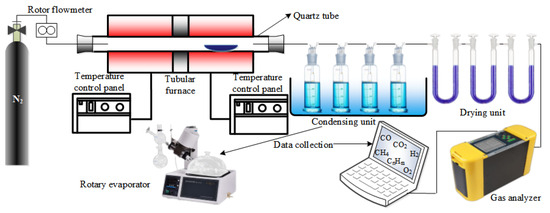
Figure 1.
Setup and process of the tube furnace experiment.
2.4. FTIR Analysis
The pyrolysis products were characterized using a VERTEX 80 FTIR spectrometer manufactured by Bruker (Karlsruhe, Germany). The biochar samples were prepared using the KBr pellet method, in which the sample was thoroughly mixed and ground with KBr powder before being pressed into pellets for analysis.
2.5. GC-MS Analysis
Gas chromatography–mass spectrometry (GC-MS) analysis was performed using an Agilent 7280A-5977E instrument (Santa Clara, CA, USA). Approximately 0.2 g of sample was dissolved in 2 g of dichloromethane, left to stand, and then subjected to GC-MS analysis.
2.6. Pyrolysis Kinetic Analysis
There are generally two approaches for analyzing the pyrolysis kinetics of biomass: non-isothermal thermogravimetric analysis and isothermal thermogravimetric analysis. Based on the Arrhenius equation, the kinetic model of biomass pyrolysis under isothermal conditions can be expressed as [16]:
where, α is the conversion rate of biomass pyrolysis, defined as α = (m0 − mt)/(m0 − mf). m0 is the initial mass fraction of the biomass (%). mt is the mass fraction at a given temperature (%). mf is the final mass fraction at the end temperature (%). k is the reaction rate constant. f(α) is the reaction mechanism function. A is the pre-exponential factor (min−1). E is the apparent activation energy (kJ/mol). R is the universal gas constant (8.314 J/mol·K). T is the absolute reaction temperature (K).
The apparent activation energy refers to the minimum energy required to convert stable molecules into an active state that can readily undergo chemical reactions. A lower apparent activation energy indicates a lower initial pyrolysis temperature for the biomass and less external energy input required. The pre-exponential factor, also known as the frequency factor, represents the number of effective collisions between activated molecules. A higher value of the frequency factor suggests more frequent effective collisions among activated molecules, making the reaction more likely to occur.
The fundamental kinetic expression for biomass pyrolysis reaction is:
For the determination of the parameters in Equation (2), commonly used mathematical methods include the Coats-Redfern method and the Doyle method.
By applying the Doyle method to Equation (2), the following expression can be derived [17]:
In this equation, ln(AE/βR) can be regarded as a constant. Therefore, the logarithmic term on the left side of the equation exhibits a linear relationship with 1/T on the right side. The slope of the resulting straight line is −1.052E/R, and the intercept is ln(AE/βR) − 5.33.
By applying the Coats-Redfern method to Equation (2), the following expression can be derived [18]:
Generally, the term 2RT/E in Equations (4) and (5) is much smaller than 1. Therefore, the expression ln[(AR/βE)(1 − 2RT/E)] can be considered approximately constant. As a result, both equations can be simplified such that the logarithmic term on the left-hand side exhibits a linear relationship with 1/T on the right-hand side. The slope of the resulting line is −E/R, and the intercept is ln[(AR/βE)(1 − 2RT/E)].
In this study, the Coats-Redfern method was employed to determine the kinetic parameters. By plotting the numerical values on the left-hand side of the equation, a straight line can be obtained if the selected reaction order n is appropriate. For the active pyrolysis stage during which significant weight loss occurs, the apparent activation energy can be calculated from the slope and intercept of the fitted straight line.
3. Results and Discussion
3.1. TG-DTG Analysis
Figure 2 presents the TG-DTG curves of PS and WS under identical pyrolysis conditions. As shown in the figure, the pyrolysis process for both PS and WS can be divided into three distinct stages: room temperature to 200 °C, 200–390 °C, and 390–800 °C. The first stage, occurring from room temperature to approximately 200 °C, corresponds mainly to the dehydration of biomass. In this stage, the weight loss for both PS and WS is less than 5%, which is attributed to the removal of free and bound (crystalline) water from the samples [19]. The second stage, ranging from 200 °C to 390 °C, is referred to by Mansaray et al. [20] as the active pyrolysis zone. This temperature range represents the main devolatilization stage during biomass pyrolysis. According to the DTG curves in Figure 2, both biomass samples exhibit their highest weight loss rates within this interval, along with pronounced DTG peaks. The maximum pyrolysis rate of PS is 19.81%/min at a peak temperature of 361.7 °C, while that of WS is 16.33%/min at a peak temperature of 340.2 °C. This indicates that biomass undergoes intense thermal decomposition in this stage, rapidly releasing large amounts of volatile matter. The maximum pyrolysis rate of PS is 3.48%/min higher than that of WS, which may be attributed to the higher hemicellulose content in WS. Since hemicellulose is the dominant component decomposing in the 200–360 °C range, a higher hemicellulose content typically leads to a lower maximum pyrolysis rate [21].
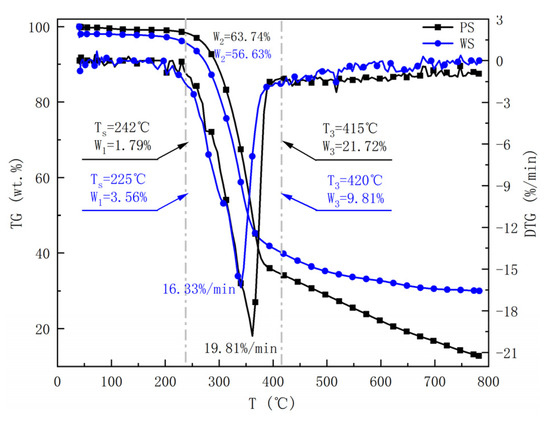
Figure 2.
TG-DTG curves of biomass pyrolysis.
As shown in the DTG curves of Figure 2, within the temperature range of 200 °C to 310 °C, the pyrolysis rate of PS is lower than that of WS. This phenomenon can be attributed to the following factors. First, herbaceous biomass such as WS generally contains higher amounts of alkali and alkaline earth metals (e.g., potassium and magnesium) compared to woody biomass like PS. These metals have catalytic effects on the pyrolytic devolatilization reactions, promoting thermal decomposition at lower temperatures [22]. Second, the difference also relates to the compositional characteristics of the two biomass types. WS typically contains a higher proportion of hemicellulose than PS. Since hemicellulose has the lowest thermal stability among the major biomass components [23], WS tends to begin its thermal decomposition at a lower temperature than PS. However, beyond 310 °C, the pyrolysis rate of PS consistently surpasses that of WS. This is likely due to the higher volatile matter content in PS, which enhances its decomposition rate at elevated temperatures.
The temperature range of 390 °C to 800 °C corresponds to the third stage of weight loss, which is primarily attributed to the slow pyrolysis of lignin. This stage is also referred to as the carbonization phase of biomass, during which a substantial amount of biochar is generated through the thermal decomposition of lignin [24]. As observed from the DTG curves in Figure 2, the pyrolysis reaction proceeds slowly in this temperature range, with no distinct weight loss rate peaks. The weight loss rate of the samples gradually approaches zero until the reaction is complete.
Thus, the TG-DTG analysis not only reveals the three-step pyrolysis pathway but also underscores the kinetic and compositional distinctions between PS and WS. The earlier decomposition of WS is governed by its higher hemicellulose and mineral content, which lowers the activation threshold, while the higher maximum weight loss rate of PS is attributed to its cellulose- and volatile-rich structure, requiring higher activation energies for decomposition. Moreover, the overlapping devolatilization of hemicellulose and cellulose in the second stage suggests potential synergistic effects that accelerate mass loss, whereas the prolonged lignin degradation in the third stage dictates the stability and yield of residual biochar. These findings establish a mechanistic link between TG-DTG behavior and biomass structure, providing a basis for interpreting subsequent kinetic and tar evolution results.
3.2. Activation Energy Analysis
Based on the TG-DTG curves in Figure 2, the active pyrolysis region for both biomass samples is mainly concentrated between 200 °C and 390 °C. Therefore, kinetic analysis of the pyrolysis reaction within this temperature range was conducted using the Coats-Redfern method. To apply the Coats-Redfern method, it is essential to determine the reaction order n. In this study, a trial-and-error approach was used to identify the appropriate value of n. The final reaction order was determined by evaluating the linear correlation coefficients corresponding to different assumed n values, with the value yielding the highest correlation coefficient selected as the optimal reaction order.
As shown in Table 2, the data fitting results for both biomass samples using the Coats-Redfern method are satisfactory, with absolute values of the linear correlation coefficients exceeding 0.99. The highest correlation was observed when the reaction order n was equal to 1, indicating the best linearity under this condition. Therefore, the reaction mechanism function for both biomass samples can be considered as a first-order reaction.

Table 2.
Linear correlation coefficients of PS and WS under different reaction orders.
The corresponding linear fitting curves are presented in Figure 3, and the linear regression equations along with the calculated activation energy values are summarized in Table 3. A comparison of the apparent activation energies of PS and WS reveals that PS has a higher activation energy than WS. This indicates that the pyrolysis of PS requires more energy to proceed than that of WS.
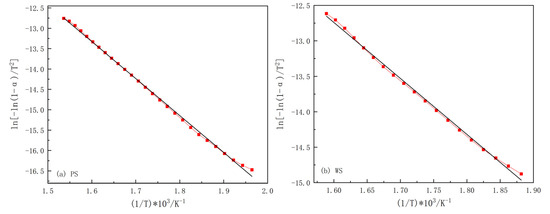
Figure 3.
Linear fitting curves of (a) PS and (b) WS.

Table 3.
Linear fitting equation and pyrolysis kinetic equation parameters of PS and WS.
3.3. Analysis of Solid Products
3.3.1. Biochar Yield
Figure 4 illustrates the variation in biochar yield with increasing pyrolysis temperature. As the temperature rises, the biochar yields of both PS and WS gradually decrease. At 800 °C, the biochar yields of PS and WS are 20.47% and 34.47%, respectively. Under the same pyrolysis temperature, PS exhibits greater mass loss and a higher degree of decomposition. The overall change in biochar yield is relatively moderate, especially for WS, which shows minimal variation at 600 °C. In this temperature range, the limited mass loss is mainly attributed to the slow thermal degradation of lignin and the release of volatiles from the biochar. In addition, the higher residual yield of WS can be explained by its elevated ash and mineral content, which catalyze cross-linking and condensation reactions, thereby stabilizing the solid phase. Conversely, the lower char yield of PS reflects its higher cellulose and volatile content, which favor gas and liquid formation rather than char retention. These results are consistent with previous studies showing that herbaceous biomass generally generates more char than woody biomass, owing to compositional differences and catalytic effects of alkali metals. From an application perspective, the relatively high char yield of WS makes it a promising feedstock for carbon sequestration or soil improvement, while the lower char yield of PS suggests its greater suitability for gas or tar production pathways.
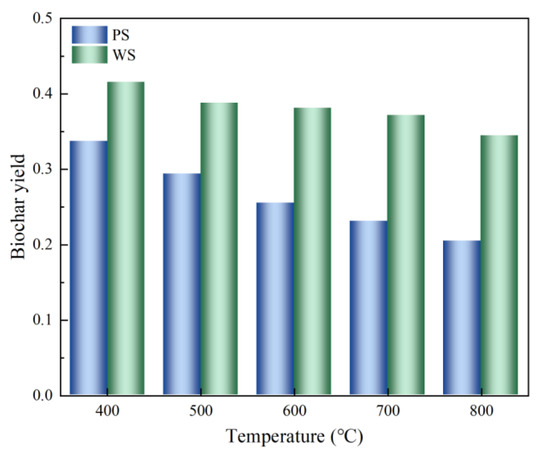
Figure 4.
Variation in biochar yield with pyrolysis temperature.
3.3.2. FTIR Analysis
Figure 5 presents the FTIR spectra of biochar derived from PS and WS at different pyrolysis temperatures. As the temperature increases, structural changes in hydrogen bonding become evident. The absorption peak in the 3750–3000 cm−1 region, corresponding to intermolecular hydrogen-bonded -OH stretching vibrations, flattens rapidly. When the pyrolysis temperature exceeds 400 °C, this peak nearly disappears, indicating a significant reduction in hydroxyl groups within the biochar. Additionally, substantial spectral changes are observed in the 1700–900 cm−1 region, which are mainly associated with transformations of C=C, C-H, and C-O functional groups. At a pyrolysis temperature of 700 °C, the spectra of the resulting char exhibit minimal further change with increasing temperature, suggesting that the biomass feedstocks have undergone near-complete thermal decomposition. The sharp decline in the -OH stretching peak (3750–3000 cm−1) between 200 °C and 400 °C further confirms that hydroxyl-containing structures are largely degraded and eliminated during this temperature range.
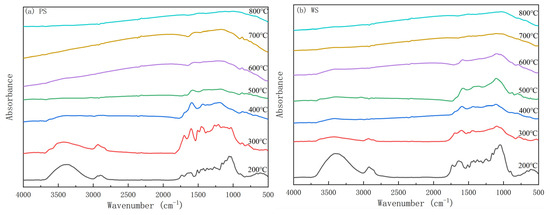
Figure 5.
FTIR spectra of biochar at different temperatures. (a) PS biochar; (b) WS biochar.
The absorption peak in the 3100–2800 cm−1 region corresponds to saturated C-H bonds, while the peak at 1590 cm−1 is attributed to aromatic C=C skeletal vibrations. The 900–700 cm−1 region represents the absorption of aromatic ring substitution patterns. These three spectral regions serve as important indicators for monitoring the evolution of aromatic structures during biomass pyrolysis. At a pyrolysis temperature of 300 °C, a distinct peak begins to emerge at 1590 cm−1, and the intensity of the saturated C-H bond peak in the 3100–2800 cm−1 region decreases significantly. This observation indicates that, at this temperature, WS begins to thermally degrade and gradually form aromatic ring structures [25].
The absorption peak in the 1750–1650 cm−1 region is primarily attributed to C=O functional groups. As the pyrolysis temperature increases, this C=O stretching peak decreases significantly and gradually flattens. By 500 °C, the peak is nearly undetectable in the FTIR spectrum. This phenomenon may be due to the thermal cleavage of C=O bonds during pyrolysis, resulting in the release of tar and small molecular gases. Since the C=O bond is relatively labile under thermal conditions, its degradation contributes to the observed decline in C=O content [26]. The 1300–1100 cm−1 region corresponds mainly to C-O stretching vibrations of ether-type functional groups. With increasing pyrolysis temperature, the intensity of this absorption peak decreases markedly, indicating a significant reduction in ether structures within the char. After 400 °C, the change in C-O content tends to stabilize, suggesting the decomposition of most ether linkages is complete by this stage.
3.3.3. Two-Dimensional Infrared Correlation Spectroscopy Analysis
Conventional one-dimensional FTIR analysis often suffers from spectral peak overlap and is limited in its ability to reveal the correlation between functional groups or chemical bonds during structural transformations. To gain deeper insight into the molecular structure evolution of biomass during pyrolysis, the traditional one-dimensional FTIR spectra were further processed in this section using two-dimensional infrared correlation spectroscopy (2D-PCIS) techniques. This approach not only enhances the spectral resolution but also effectively reveals the interrelationships among functional groups, providing a more detailed understanding of structural changes during the thermal conversion process [27]. The decision rules of cross peak of 2D-PCIS are shown in Table 4.

Table 4.
Decision rules of cross peak of 2D-PCIS.
In the 2D-PCIS analysis, the positive and negative signs indicate the correlation between changes of different functional groups. “+” indicates that the peak response value in the 2D-PCIS spectrum is positive, while “−” indicates that the peak response value in the 2D-PCIS spectrum is negative.
2D-PCIS Analysis of WS
Figure 6 shows the 2D-PCIS synchronous spectrum of biochar derived from WS. Seven autopeaks are observed across the three spectral regions, corresponding to the following functional groups: hydrogen-bonded -OH (3402 cm−1), methylene -CH2 (2920 cm−1), aliphatic olefinic C=C (1645 cm−1), tertiary hydroxyl C-OH (1145 cm−1), primary alcohol C-OH (1043 cm−1), olefinic C-H (918 cm−1), and substituted aromatic ring C-H (852 cm−1). These autopeaks represent functional groups that are most sensitive to temperature changes, and they are typically associated with reactions such as ring-opening of cyclic macromolecules, aromatization, and condensation of hydrocarbon chains.
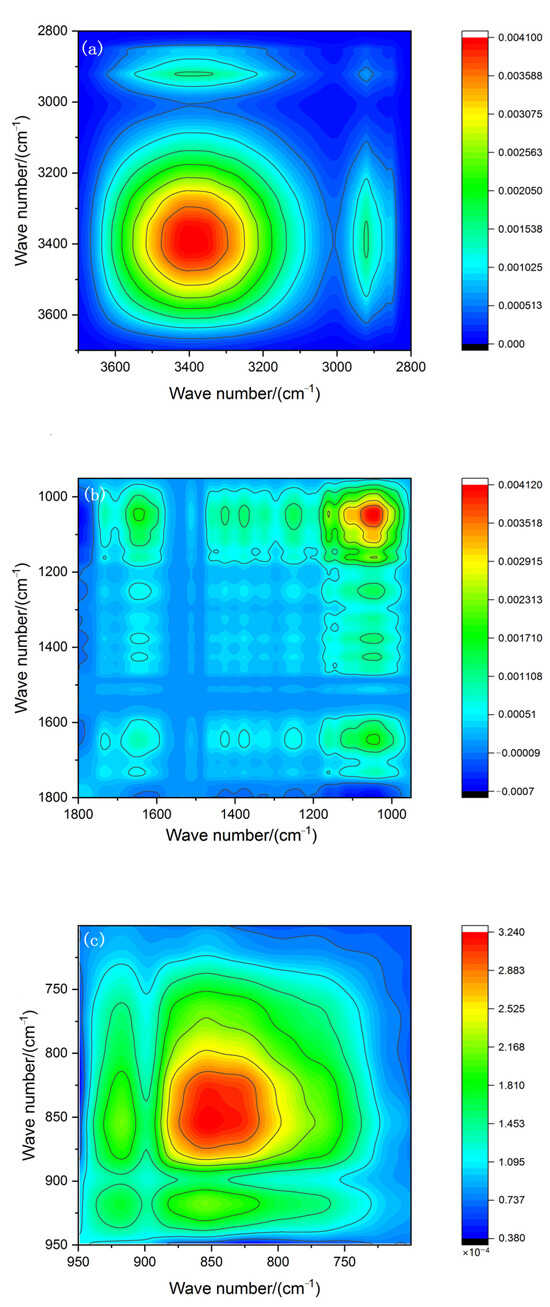
Figure 6.
2D-PCIS synchronous spectrum of WS biochar. (a) 3700–2800 cm−1; (b) 1800–950 cm−1; (c) 950–700 cm−1.
A total of 14 cross-peaks are observed in the synchronous 2D-PCIS spectrum. In the 3700–2800 cm−1 region, the cross-peaks mainly correspond to methyl and hydroxyl groups, with fewer peaks present. The cross-peak Φ(3392, 2918) is positive, indicating that the hydrogen-bonded -OH and methylene -CH2 groups exhibit similar change trends. In the 1800–950 cm−1 region, numerous autopeaks and cross-peaks are detected. Positive cross-peaks Φ(1161, 1733), Φ(1161, 1043), Φ(1650, 1043), Φ(1249, 1043), and Φ(1377, 1043) suggest that tertiary hydroxyl (C-OH), carboxyl (C=O), primary alcohol (C-OH), aliphatic olefinic (C=C), aromatic ether (C-O-C), and methyl (-CH3) groups share similar change trends. Most of these functional groups originate from the native components of wheat straw, and thus display coordinated transformation behavior during pyrolysis [28]. The positive cross-peak Φ(1425, 1043) indicates that the primary alcohol C-OH and aromatic C-C structures change in a similar manner; notably, aromatic C-C structures are key constituents of char. Additionally, the positive cross-peak Φ(1645, 1251) shows consistent changes between olefinic C=C and aromatic ether C-O-C groups, likely due to dehydration or ring-opening reactions of six-membered heterocyclic compounds such as pyrans [29]. In the 950–700 cm−1 region, which mainly represents C-H vibrations of benzene rings and olefins, the positive cross-peak Φ(918, 852) suggests that during the pyrolysis of WS, the transformation of olefinic C-H and substituted aromatic ring C-H occurs in parallel.
Figure 7 shows the 2D-PCIS asynchronous spectrum of WS biochar. In the asynchronous spectrum, three pairs of cross-peaks, Ψ(1296, 1056), Ψ(1161, 1488), and Ψ(905, 830), correspond to those observed in the synchronous spectrum. Among them, both Ψ(905, 830) and Φ(918, 852) are positive. According to Noda’s rule, this indicates that the structural change in the olefinic C-H group occurs earlier than that of the substituted aromatic ring C-H group. For the cross-peak pair Φ(1249, 1043) (positive) and Ψ(1296, 1056) (negative), Noda’s rule suggests that the transformation of the aromatic ether C-O-C group occurs later than that of the primary alcohol C-OH group. Similarly, both Φ(1145, 1348) and Ψ(1161, 1488) are positive, indicating that the structural change in the tertiary hydroxyl C-OH group precedes that of the methyl -CH3 group. This may be due to the dehydroxylation reaction of wheat straw occurring earlier than demethylation. Additionally, a large number of other cross-peaks are observed in the asynchronous spectrum. However, due to the complex composition of biomass and the absence of corresponding peaks in the synchronous spectrum, the sequence of structural changes for these functional groups cannot be determined based on Noda’s rule.
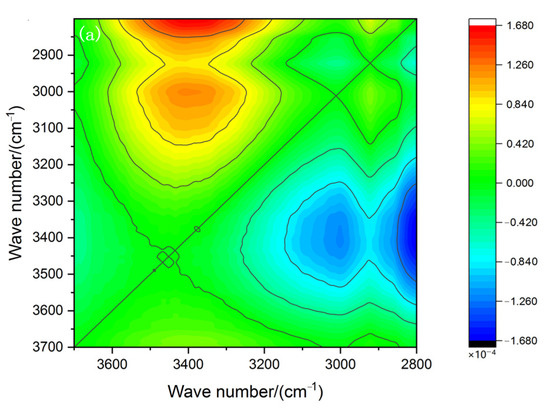
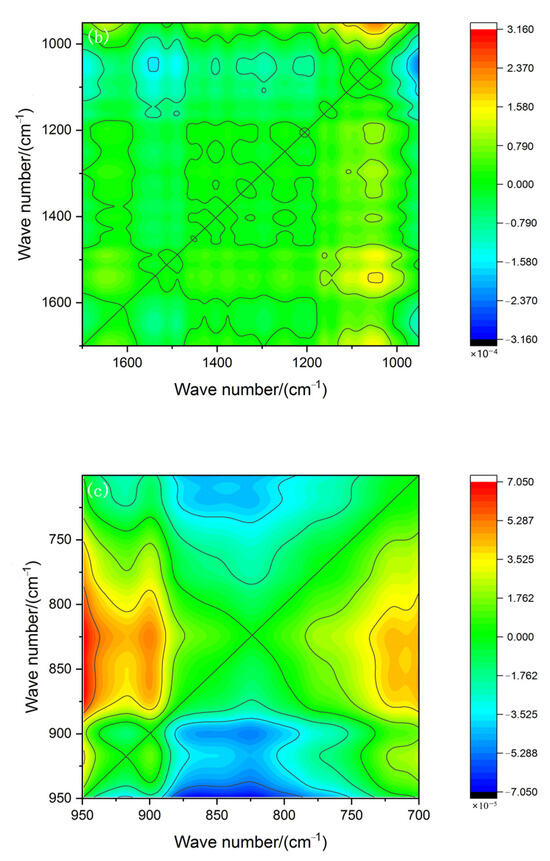
Figure 7.
2D-PCIS asynchronous spectrum of WS biochar. (a) 3700–2800 cm−1; (b) 1700–950 cm−1; (c) 950–700 cm−1.
2D-PCIS Analysis of PS
Figure 8 shows the 2D-PCIS synchronous spectrum of biochar derived from PS. A total of 13 autopeaks are observed in the synchronous spectrum, corresponding to the following functional groups: hydrogen-bonded -OH (3383 cm−1), primary alcohol C-OH (1053 cm−1), phenolic hydroxyl C-OH (1180 cm−1), aliphatic ether C-O-C (1212 cm−1), aromatic ether C-O-C (1267 cm−1), methyl -CH3 (1393 and 1485 cm−1), aromatic C-C (1454 and 1600 cm−1), condensed aromatic C-C (1539 cm−1), carbonyl C=O (1699 cm−1), and substituted benzene ring C-H (829 cm−1). Compared with WS, PS exhibits more autopeaks, indicating a greater diversity of functional groups. A total of 30 cross-peaks are observed across the three spectral regions, most of which are located within the 1800–950 cm−1 range. All cross-peaks in this range show positive values, suggesting that the functional groups in this region (similar to those in WS) mostly originate from the inherent structure of the biomass and are involved in depolymerization and polycondensation reactions, thus exhibiting consistent variation trends during pyrolysis [30]. Among these, the condensed aromatic C-C group (1539 cm−1) forms several cross-peaks with other functional groups, including Φ(1539, 1383), Φ(1539, 1180), Φ(1539, 1662), Φ(1539, 1180), and Φ(1539, 1134). These cross-peaks are all at the lowest contour levels and close to zero, indicating that the condensed aromatic C-C structure undergoes only slight changes during pyrolysis. The cross-peak Φ(3383, 3020) is negative, indicating an opposite variation trend between hydrogen-bonded -OH and aromatic C-H. Based on the one-dimensional FTIR difference spectra, the content of -OH gradually decreases, implying that the content of aromatic C-H increases correspondingly. However, the sequence of structural changes between these two functional groups requires further analysis using the asynchronous spectrum. No cross-peaks were observed in the 950–700 cm−1 region.
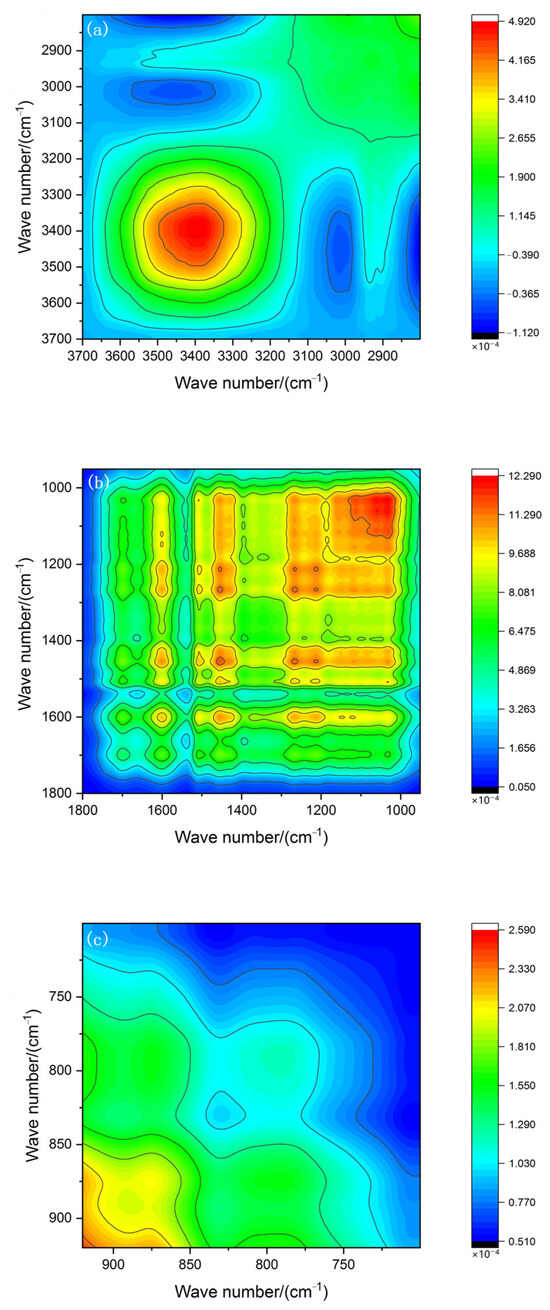
Figure 8.
2D-PCIS synchronous spectrum of PS biochar. (a) 3700–2800 cm−1; (b) 1800–950 cm−1; (c) 925–700 cm−1.
Figure 9 shows the 2D-PCIS asynchronous spectrum of biochar derived from PS. A large number of cross-peaks are observed in the asynchronous spectrum; however, only the cross-peaks Ψ(1454, 1212), Ψ(1699, 1033), Ψ(1699, 1504), and Ψ(1377, 1199) have corresponding cross-peaks in the synchronous spectrum. Among them, Φ(1454, 1212) is positive and Ψ(1454, 1212) is negative, indicating that the aromatic C-C and aliphatic ether C-O-C exhibit similar variation trends, but the structural change in aromatic C-C occurs later than that of aliphatic ether C-O-C. Both Φ(1699, 1033) and Ψ(1699, 1033) are positive, suggesting that carbonyl C=O and primary alcohol C-OH vary in the same trend, and the carbonyl C=O undergoes structural change earlier than the primary alcohol C-OH. Both Φ(1699, 1504) and Ψ(1699, 1504) are positive, indicating a consistent trend between carbonyl C=O and aromatic C-C, with the carbonyl group changing earlier than the aromatic C-C structure. Φ(1377, 1201) is positive while Ψ(1393, 1212) is negative, suggesting that methyl -CH3 and aliphatic ether C-O-C show similar trends, but the change in methyl -CH3 occurs later than that of aliphatic ether C-O-C. These observations indicate that most of the functional group transformations in PS that can be sequentially identified via Noda’s rule are associated with synergistic reactions of aliphatic molecules. One typical transformation pathway is -OCH3 → -CH3, implying that aliphatic molecular reactions are relatively intense during the pyrolysis of PS. Meanwhile, both the methyl -CH3 and aliphatic ether C-O-C groups exhibit varying degrees of wavenumber shifts, which may be attributed to structural rearrangements in aromatic ring linkages and methyl substituents during char formation [31].
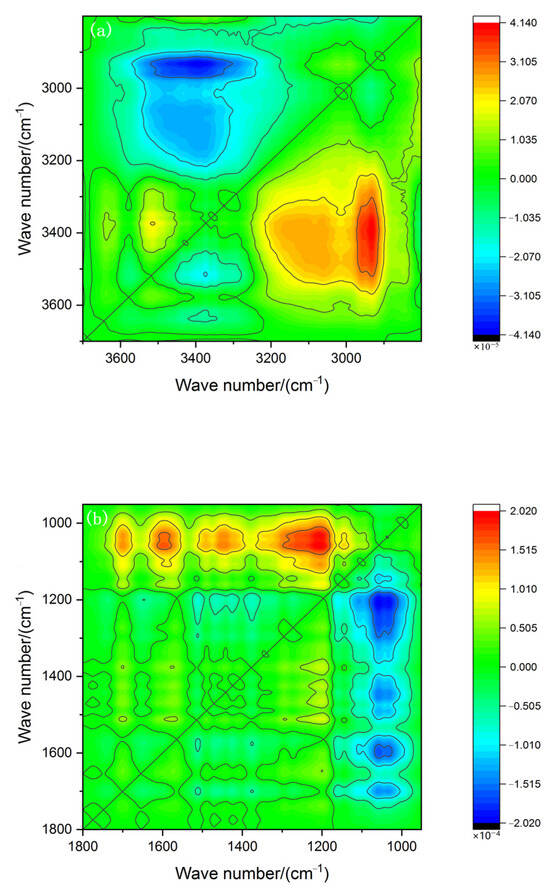
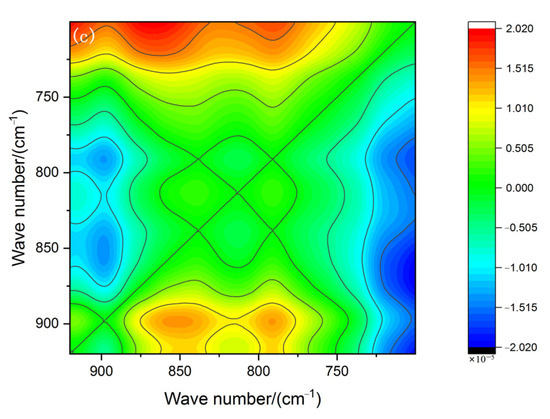
Figure 9.
2D-PCIS asynchronous spectrum of PS biochar. (a) 3700–2800 cm−1; (b) 1800–900 cm−1; (c) 925–700 cm−1.
The comparative analysis of 2D-PCIS spectra between WS and PS reveals clear differences in their structural evolution during pyrolysis. For WS, the synchronous and asynchronous spectra indicate that hydroxyl and aliphatic groups undergo early transformations, while aromatic structures emerge at later stages, reflecting the catalytic effect of alkali/alkaline earth metals and the higher hemicellulose content that accelerates initial decomposition. In contrast, PS exhibits a larger number of autopeaks and cross-peaks, indicating a greater diversity of functional groups and more complex transformation pathways. The asynchronous spectra suggest that functional groups in PS are primarily involved in sequential aliphatic reactions (e.g., -OCH3 → -CH3), with aromatic C-C structures forming more gradually and exhibiting delayed stabilization compared with WS. These results imply that WS favors rapid dehydration and early aromatization, while PS undergoes more extensive aliphatic rearrangements before condensation into stable aromatic char. The complementary insights obtained from 2D-PCIS analysis not only highlight the structural dependence of functional group evolution on biomass type but also provide mechanistic evidence for explaining the observed differences in char yield, reactivity, and tar formation dynamics between herbaceous and woody biomass.
3.4. Biomass Tar Analysis
3.4.1. Tar Yield Analysis
Figure 10 shows the biomass tar yields of WS and PS during pyrolysis within the temperature range of 400 °C to 800 °C. The yield of biomass tar is generally influenced by the interplay between the rate of tar formation and the rate of secondary cracking of the tar [32]. Secondary cracking leads to the decomposition of tar into small molecular compounds, thereby reducing the overall tar content. Increasing the pyrolysis temperature promotes both the formation and cracking of tar. As illustrated in the figure, the tar yields of both types of biomass increase rapidly with temperature and reach their respective maximum values at 700 °C. This indicates that in the temperature range of 400–700 °C, the rate of tar formation exceeds that of secondary cracking, with tar production dominating the process. However, when the temperature rises from 700 °C to 800 °C, the tar yields for both biomasses decrease significantly. This suggests that above 700 °C, secondary cracking becomes the dominant process, with higher temperatures accelerating the breakdown of tar into smaller molecular compounds. Yu et al. [33] also confirmed this trend through experiments on wood pyrolysis in a free-fall reactor, showing that tar yields decreased significantly as the pyrolysis temperature increased from 700 °C to 900 °C.
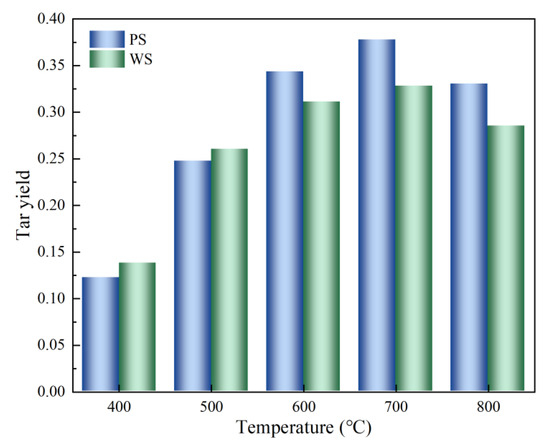
Figure 10.
Tar yield of WS and PS at different pyrolysis temperatures.
As shown in Figure 10, the tar yield of WS is higher than that of PS at temperatures below 600 °C. However, when the temperature reaches 600 °C, the tar yield of WS gradually levels off, showing minimal variation, while the tar yield of PS continues to increase significantly. This phenomenon can be attributed to two main factors. WS is an herbaceous biomass, whereas PS is a woody biomass. Herbaceous biomass typically contains higher levels of alkali and alkaline earth metals (e.g., K, Na) compared to woody biomass. These metals can catalyze biomass pyrolysis reactions, promoting decomposition at lower external energy inputs [34]. As a result, the pyrolysis of WS proceeds earlier than that of PS. The chemical composition of the biomass also contributes to this behavior. Among the three main biomass components (hemicellulose, cellulose, and lignin), the pyrolysis order is typically hemicellulose > cellulose > lignin, meaning hemicellulose has the lowest thermal stability and reduces the initial pyrolysis temperature [35].
3.4.2. Tar Composition Analysis
Biomass tar is a highly complex mixture, primarily composed of aromatic derivatives (such as substituted benzenes) and aliphatic compounds. It is characterized by high oxygen content and strong corrosiveness. Figure 11 presents the GC-MS chromatograms of tar produced from the pyrolysis of WS at temperatures ranging from 400 °C to 800 °C. Compounds such as Phenol, Phenol, 2-methoxy-, Phenol, 2-methyl-, Creosol, Phenol, 4-ethyl-2-methoxy-, 2-Methoxy-4-vinylphenol, and Phenol, 2,6-dimethoxy- were detected at all pyrolysis temperatures, each with a relative content above 2%. These compounds all contain aromatic rings, indicating that aromatic ring-containing compounds are the dominant constituents of WS tar. As temperature increases, the relative contents of 2-Furanmethanol and 2-Cyclopenten-1-one change in a similar manner but with only minor fluctuations. The content of Phenol increases gradually at lower temperatures but decreases from 5.37% to 4.18% when the temperature exceeds 500 °C. Phenol, 2-methoxy-, an important lignin-derived compound in biomass, can thermally degrade into Phenol, Cresol, and Catechol [36]. Its relative content increases at lower temperatures, reaching a peak of 10.03%, but then declines to 5.75% at temperatures above 500 °C. Interestingly, its content at 800 °C is higher than at 700 °C, which may be due to the extensive decomposition of unstable small-molecule tars such as aliphatic hydrocarbons at higher temperatures, thereby increasing the relative proportion of certain more stable tar compounds. In addition, many key components—such as 2-Methoxy-4-vinylphenol—tend to increase in concentration at lower temperatures and then decrease as the pyrolysis temperature rises, reflecting their thermal stability and secondary cracking behavior at elevated temperatures.
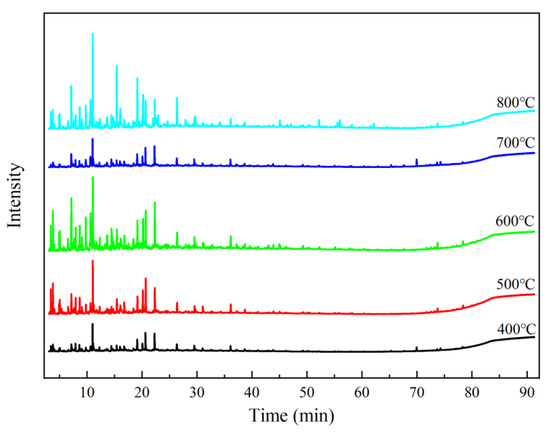
Figure 11.
GC-MS detection spectra of WS tar at different temperatures.
The decline in the relative content of certain tar components can generally be attributed to two main factors. As the pyrolysis temperature increases, a wider variety of tar compounds are generated. At 700 °C, the diversity of tar species reaches its peak, which is consistent with the maximum tar yield observed at this temperature. The emergence of new tar components leads to a decrease in the relative proportion of existing ones. Additionally, with increasing temperature, some tar components undergo thermal cracking or transformation reactions, resulting in a reduced content of those specific compounds. These two mechanisms are strongly influenced by temperature. At lower pyrolysis temperatures, the decrease in relative content is mainly due to the growing number of newly formed tar species. In contrast, at higher temperatures, the decline is primarily caused by thermal decomposition and conversion of the tar compounds themselves, as most tar species volatilize from the biomass at lower temperatures and undergo cracking reactions when subjected to greater external energy input [37].
Figure 12 shows the variation in the relative content of different compound classes in WS tar at various pyrolysis temperatures. Monocyclic aromatic compounds are the predominant components at all temperatures, accounting for more than 40% of the total tar composition. These include phenol, methylphenol, and ethylphenol. The relative content of monocyclic aromatic compounds increases significantly with rising pyrolysis temperature, from 43% to approximately 68%, indicating that tar components are gradually converting into more stable benzene ring structures. This trend may be attributed to the higher chemical stability of the benzene ring compared to other chemical bonds present in biomass, such as C-O, C-H, and O-H bonds. At elevated temperatures, these weaker bonds tend to break and undergo chemical reactions. Some of the resulting fragments form small gas molecules such as CO and H2, while others undergo cyclization reactions to generate aromatic structures. For example, ketones can cyclize at high temperatures to form phenolic compounds, and small aliphatic hydrocarbons may polymerize to produce aromatic compounds under high-temperature conditions [38,39].
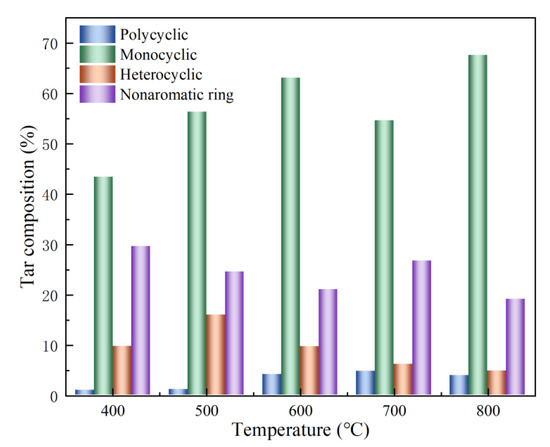
Figure 12.
Composition changes in WS tar at different pyrolysis temperatures.
The relative content of non-aromatic compounds (excluding heterocycles) decreases significantly with increasing pyrolysis temperature, dropping from approximately 30% to 19%. This is likely because higher temperatures provide more energy for chemical reactions in tar, promoting the breakdown of chain-like compounds into small molecular radicals, which then recombine to form other types of substances. For instance, C-H bond cleavage can lead to the formation of H2 and other gases. The relative content of ketones first increases and then decreases as the temperature rises. This is primarily due to the high oxygen content in the biomass feedstock—elevated temperatures facilitate the cleavage of long-chain compounds, promoting the formation of C=O structures through reactions between carbon and oxygen atoms [40]. However, at temperatures above 500 °C, ketones and aldehydes begin to convert into aromatic compounds and small gaseous molecules, resulting in a reduction in their relative content [41].
Polycyclic aromatic hydrocarbons (PAHs) in the tar are mainly composed of bicyclic compounds such as naphthalene, tricyclic compounds like fluorene, and their derivatives. At low pyrolysis temperatures, PAHs are present in negligible amounts. However, when the temperature reaches around 600 °C, these compounds begin to form. This is primarily due to the occurrence of tertiary reactions of mononuclear aromatic compounds in the tar. Specifically, mononuclear aromatics gradually undergo dehydrogenation, cyclization, and other reactions, leading to the formation of more thermodynamically stable polycyclic aromatic structures.
The relative content of heterocyclic compounds shows a trend of first increasing and then decreasing with rising pyrolysis temperature, rising from 9.7% at 400 °C to a peak of 16% at 500 °C, and then gradually declining to 4.8% at 800 °C—a noticeable downward trend. This change is mainly attributed to the variation in the proportion of furan compounds, while other types of heterocycles remain relatively stable. When the temperature exceeds 500 °C, the proportion of furans begins to drop significantly. This may be because most furan compounds have already volatilized and been released around 500 °C. The further increase in temperature leads to the generation of additional tar components, reducing the relative share of furans. Moreover, high temperatures promote the ring-opening reactions of furan compounds, which then convert into linear intermediates and subsequently degrade into small gaseous molecules.
3.5. Analysis of Gas Product Release Behavior
Figure 13 presents the gas release profiles during the pyrolysis of PS and WS under a N2 atmosphere, heated at a rate of 10 °C/min to 800 °C, followed by a 60 min isothermal stage and subsequent natural cooling. As shown, the onset temperatures for gas evolution are relatively close for both biomass types. This similarity can be attributed to their common major constituents—cellulose, hemicellulose, and lignin—which share similar thermal decomposition pathways, resulting in comparable temperature-dependent gas evolution trends. However, the relative intensities and peak shapes of the gas release curves differ due to the varying proportions of these components in the two feedstocks. For instance, the maximum CO release from WS (19.45%) is notably higher than that of PS (16.48%), primarily due to differences in the thermal cleavage of hydroxyl groups (-OH) within the cellulose and hemicellulose fractions. Additionally, WS exhibits a more pronounced secondary CO peak, which is weaker in PS; this variation is likely related to distinct ether bond cleavage behaviors within the lignin structure.
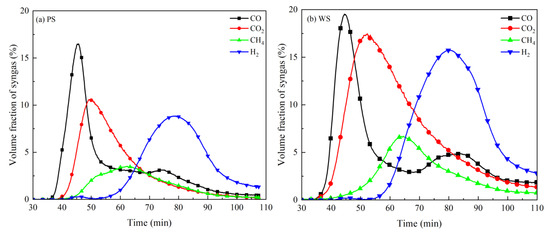
Figure 13.
Syngas release profiles during the pyrolysis of (a) PS and (b) WS.
A strong correlation is also observed between the peak intensities of CO and CO2. WS exhibits a higher maximum CO2 yield (17.33%) compared to PS (10.58%). The CO2 peaks generally appear at slightly higher temperatures than those of CO, suggesting a delayed release pattern. The CO2 evolution is more gradual and steady, attributed to its formation mainly via secondary reactions of dehydrated cellulose. In contrast, the generation of CO is more sensitive to high-temperature devolatilization, while its contribution to CO2 formation remains limited [42]. CH4 is produced in relatively small quantities, with peak values of 6.72% for WS and 3.51% for PS. As a key indicator of pyrolysis efficiency, H2 yields are significantly higher in WS (15.73%) than in PS (8.85%), and the release window is also broader for WS. The distinct gas evolution characteristics between the two biomasses can be primarily ascribed to differences in the relative contents of cellulose, hemicellulose, and lignin. Among these, hemicellulose plays a crucial role in determining the yield of non-condensable gases. Additionally, the presence and types of alkali metal salts in the biomass may influence gas formation, as these species can catalyze ring-opening reactions and promote the formation of smaller gaseous molecules during thermal decomposition [43].
4. Conclusions
Both WS and PS undergo three major stages during pyrolysis. PS exhibited a higher maximum weight loss rate (19.81%/min) than WS (16.33%/min), with differences in decomposition behavior primarily observed beyond 310 °C. A lower heating rate favored the complete thermal cracking of biomass tar, and most of the tar was decomposed above 500 °C. The activation energy of PS (75.44 kJ/mol) was higher than that of WS (65.63 kJ/mol), indicating a greater energy demand for PS pyrolysis. Increased heating rates led to higher activation energies for both volatilization and primary cracking reactions, suggesting that lower heating rates promote easier tar degradation.
The evolution of functional groups in biomass char indicated significant structural transformations at 200–400 °C, with aromatic ring structures forming above 300 °C. Beyond 700 °C, most functional groups had decomposed, and biomass pyrolysis was nearly complete. For WS char, changes in functional groups such as tertiary hydroxyl (C-OH), carboxyl (C=O), and aliphatic olefins (C=C) occurred earlier than those in PS char. In contrast, PS char showed delayed transformation of aromatic structures (C-C) and methyl groups (-CH3), reflecting compositional differences in their lignocellulosic structures.
Tar yield increased with temperature and peaked at 700 °C, with PS producing a higher yield (37.79%) than WS (32.82%). The difference in pyrolysis reactivity was attributed to the variation in alkali metal content and biomass composition. Aromatic hydrocarbons were the dominant tar components, typically bearing reactive side chains such as methyl and ethyl groups. Primary tar compounds included monocyclic aromatics, while polycyclic aromatic hydrocarbons (PAHs) emerged significantly above 600 °C. Below 500 °C, primary tar compounds were mostly formed through bond cleavage and volatilization. As temperature increased beyond 500–600 °C, the tar underwent further deoxygenation, ring growth, and aromatization, leading to the formation of stable monocyclic and polycyclic aromatic compounds. Eventually, these aromatics transformed into heavier residues such as soot.
The novelty of this work lies in establishing a direct comparative link between herbaceous (WS) and woody (PS) biomass in terms of their pyrolysis kinetics, functional group transformations, and tar molecular evolution. By integrating thermogravimetric, spectroscopic, and tar composition analyses, this study provides new mechanistic insights into how feedstock-specific structures and minerals control pyrolysis reactivity and secondary tar conversion. These findings contribute to the rational design of pyrolysis and tar mitigation strategies tailored for different biomass resources.
Author Contributions
Conceptualization, methodology and supervision, K.X.; writing—original draft, J.L.; writing—review and editing, X.Y. and X.L. All authors have read and agreed to the published version of the manuscript.
Funding
This research work was funded by the Joint Fund of Natural Science Foundation of Liaoning Province (2023-BSBA-106) and Fundamental Research Funds for the Central Universities (N2401021).
Data Availability Statement
The corresponding author can provide the datasets upon an adequate request.
Conflicts of Interest
The authors declare that they have no known competing financial interests or personal relationships that could have appeared to influence the work reported in this paper.
References
- Wang, L.; Lin, D.; Liu, D.; Xie, X.; Zhang, S.; Li, B. Oxidative Pyrolysis of Typical Volatile Model Compounds Under Low Oxygen Equivalence Ratios During Oxidative Pyrolysis of Biomass. Energies 2025, 18, 2996. [Google Scholar] [CrossRef]
- Mengesha, T.T.; Ancha, V.R.; Nigussie, A.; Afessa, M.M. Effect of Particle Size and Heating Rate on Formation of Polycyclic Aromatic Hydrocarbons During Corn Cob Biomass Pyrolysis. Sustainability 2025, 17, 4962. [Google Scholar] [CrossRef]
- Li, J.; Wang, T.; Hao, T.; Yao, X.; Xu, K.; Liu, J. Application of Biochar Catalysts in Tar Catalytic Reforming: A Review on Preparation, Modification, Deactivation, and Regeneration. Energy 2025, 317, 134734. [Google Scholar] [CrossRef]
- Li, J.; Xu, K.; Yao, X.; Liu, J. Investigation of Biomass Slow Pyrolysis Mechanisms Based on the Generation Trends in Pyrolysis Products. Process Saf. Environ. Prot. 2024, 183, 327–338. [Google Scholar] [CrossRef]
- Daryono, E.; Jimmy; Setyawati, H. Production of Biodiesel Without Catalyst Separation with Palm Oil Interesterification Process Using Essential Oil Biocatalyst. Chem. Chem. Technol. 2025, 356–362. [Google Scholar] [CrossRef]
- Li, J.; Xu, K.; Yao, X.; Liu, J.; Su, D. Study on the Effect of Biochar Catalyst on the Formation of Biomass Slow Pyrolysis Products. Fuel 2025, 392, 134862. [Google Scholar] [CrossRef]
- Dhaundiyal, A. Pyrolysis Kinetics of Pine Waste Based on Ensemble Learning. Energies 2025, 18, 2556. [Google Scholar] [CrossRef]
- Zhao, L.; Li, J.; Xu, K. Analysis of the Pyrolysis and Combustion Behavior and Product Release Characteristics of Chinese Medicine Residue under a Nitrogen/Oxygen Atmosphere. Biomass Bioenergy 2025, 197, 107824. [Google Scholar] [CrossRef]
- Pstrowska, K.; Łużny, R.; Fałtynowicz, H.; Jaroszewska, K.; Postawa, K.; Pyshyev, S.; Witek-Krowiak, A. Unlocking Sustainability: A Comprehensive Review of Up-Recycling Biomass Waste into Biochar for Environmental Solutions. Chem. Chem. Technol. 2025, 19, 211–231. [Google Scholar] [CrossRef]
- Sun, S.; Wan, J.; Fu, H.; Sun, Y.; Shao, F.; Ni, D.; Lu, J. Influence of Pyrolysis on Biomass Structure: Microscopic Deformation Patterns and Chemical Composition Variations. Fuel 2026, 403, 136090. [Google Scholar] [CrossRef]
- Mingzhe, L.; Mcintyre, S.R.; Iacomi, P.; Everden, K.; Williams, P.T.; Zong, S.; Liu, X.; Zhu, X.; Yang, Y.; Li, S.; et al. Biochar Production, Activation, and Applications: A Comprehensive Technical Review. Carbon Capture Sci. Technol. 2025, 16, 100421. [Google Scholar] [CrossRef]
- Ko, H.; Lee, M.; Sen, R. Pyrolysis Characteristics of Empty Fruit Bunches at Different Temperatures and Heating Rates. Energies 2025, 18, 1404. [Google Scholar] [CrossRef]
- Li, J.; Xu, K.; Yao, X.; Liu, J. Slow Pyrolysis Experimental Investigation on the Tar Formation and Its Pyrolysis Behavior Characteristics. Process Saf. Environ. Prot. 2024, 184, 660–671. [Google Scholar] [CrossRef]
- Bi, H.; Wang, C.; Jiang, X.; Jiang, C.; Bao, L.; Lin, Q. Thermodynamics, Kinetics, Gas Emissions and Artificial Neural Network Modeling of Co-Pyrolysis of Sewage Sludge and Peanut Shell. Fuel 2021, 284, 118988. [Google Scholar] [CrossRef]
- Han, Y.; Boateng, A.A.; Qi, P.X.; Lima, I.M.; Chang, J. Heavy Metal and Phenol Adsorptive Properties of Biochars from Pyrolyzed Switchgrass and Woody Biomass in Correlation with Surface Properties Q. J. Environ. Manag. 2013, 118, 196–204. [Google Scholar] [CrossRef] [PubMed]
- Chen, H.; Wang, F.; Zhang, D.; Deng, H.; Wen, X.; Chen, G. Kinetic and Thermodynamic Analysis of Synergistic Pyrolysis of Salix Psammophila and Plastic Waste. Thermochim. Acta 2025, 751, 180060. [Google Scholar] [CrossRef]
- Kandan, J.A.; Chithra, K. Musa Paradisiaca Peel and Sludge Co-Pyrolysis: Thermal Behavior and Kinetic Analysis. Sustain. Chem. Environ. 2025, 10, 100258. [Google Scholar] [CrossRef]
- Hadou, A.; Belaadi, A.; Alshaikh, I.M.H. Pyrolysis Features of Dracaena Draco Lignocellulosic Fibers: Kinetic and Thermodynamic Analysis at Various Heating Rates through Coats-Redfern Method. Case Stud. Therm. Eng. 2024, 64, 105406. [Google Scholar] [CrossRef]
- Zhu, L.; Zhong, Z. Effects of Cellulose, Hemicellulose and Lignin on Biomass Pyrolysis Kinetics. Korean J. Chem. Eng. 2020, 37, 1660–1668. [Google Scholar] [CrossRef]
- Mansaray, K.G.; Ghaly, A.E. Thermal Degradation of Rice Husks in Nitrogen Atmosphere. Bioresour. Technol. 1998, 65, 13–20. [Google Scholar] [CrossRef]
- Piazza, V.; Batista, R.; Frassoldati, A.; Lietti, L.; Gambaro, C.; Rajendran, K.; Chen, D.; Faravelli, T.; Beretta, A. Unravelling the Complexity of Hemicellulose Pyrolysis: Quantitative and Detailed Product Speciation for Xylan and Glucomannan in TGA and Fixed Bed Reactor. Chem. Eng. J. 2024, 497, 154579. [Google Scholar] [CrossRef]
- Liu, N.; Huang, H.; Feng, J.; Li, R.; Huang, X.; Wu, Y. Effects of Alkali and Alkaline Earth Metals in Biomass on Co-Pyrolysis Characteristics and Product Distribution of Coal and Biomass. Fuel 2025, 389, 134551. [Google Scholar] [CrossRef]
- Zheng, K.; Hu, S.; Gong, Z.; Jia, M.; Xu, K.; Xu, J.; Jiang, L.; Wang, Y.; Su, S.; Xiang, J. Interaction among Cellulose, Hemicellulose and Lignin during Pressurized Pyrolysis: Importance of Deoxygenation and Aromatization Reactions. Energy 2025, 314, 134320. [Google Scholar] [CrossRef]
- Cristina, A.; Araujo, D.; Funke, A.; Margellou, A.; Triantafyllidis, K.; Dahmen, N. Pilot Scale Fast Pyrolysis of Lignin in a Twin-Screw Reactor. Biomass Bioenergy 2025, 200, 108041. [Google Scholar] [CrossRef]
- Guo, Y.; Tan, M.; Zhu, Y.; Yang, W.; Lei, T.; Huang, Z.; Xiao, Z.; Wu, Z.; Li, H. The Effect of Additives on the Storage and Pyrolysis of Biomass: Greenhouse Gas Reduction and Biochar’s Properties Variation. Biomass Bioenergy 2025, 197, 107828. [Google Scholar] [CrossRef]
- Qiu, T.; Li, C.; Zhao, W.; Yasin, M.; Zhang, Y. Microwave-Assisted Pyrolysis of Biomass: Influence of Feedstock and Pyrolysis Parameters on Porous Biochar Properties. Biomass Bioenergy 2025, 193, 107583. [Google Scholar] [CrossRef]
- Tu, R.; Sun, Y.; Wu, Y.; Fan, X.; Jiang, E.; Xu, X. The Fuel Properties and Adsorption Capacities of Torre Fi Ed Camellia Shell Obtained via Different Steam-Torrefaction Reactors. Energy 2022, 238, 121969. [Google Scholar] [CrossRef]
- Song, Y.; Tan, J.; Jin, M.; Liu, Z.; Zhu, J.; El-sayed, M.E.A.; Abdelhafeez, I.A.; Zhang, Y.; Shen, Z. Effect of Pyrolysis Temperature and Heating Rate on the Physicochemical Properties of Alkali Lignin-Derived Biochar: A Comparative Study of Fast and Slow Pyrolysis. J. Anal. Appl. Pyrolysis 2025, 191, 107236. [Google Scholar] [CrossRef]
- Leng, E.; Zhang, Y.; Peng, Y.; Gong, X.; Mao, M.; Li, X.; Yu, Y. In Situ Structural Changes of Crystalline and Amorphous Cellulose during Slow Pyrolysis at Low Temperatures. Fuel 2018, 216, 313–321. [Google Scholar] [CrossRef]
- Zhang, H.; Liu, M.; Yang, H.; Jiang, H.; Chen, Y.; Zhang, S.; Chen, H. Impact of Biomass Constituent Interactions on the Evolution of Char ’ s Chemical Structure: An Organic Functional Group Perspective. Fuel 2022, 319, 123772. [Google Scholar] [CrossRef]
- Liu, R.; Liu, G.; Yousaf, B.; Niu, Z.; Abbas, Q. Novel Investigation of Pyrolysis Mechanisms and Kinetics for Functional Groups in Biomass Matrix. Renew. Sustain. Energy Rev. 2022, 153, 111761. [Google Scholar] [CrossRef]
- Kawamoto, K. Gas and Tar Formation Characteristics in Gasification for Biomass Materials. Chemosphere 2025, 385, 144535. [Google Scholar] [CrossRef]
- Yu, Q.; Brage, C.; Nordgreen, T.; Sjöström, K. Effects of Chinese Dolomites on Tar Cracking in Gasification of Birch. Fuel 2009, 88, 1922–1926. [Google Scholar] [CrossRef]
- Wang, S.; Liu, Q.; Liao, Y.; Luo, Z. A Study on the Mechanism Research on Cellulose Pyrolysis under Catalysis of Metallic Salts. Korean J. Chem. Eng. 2007, 24, 336–340. [Google Scholar] [CrossRef]
- Song, G.; Huang, D.; Ren, Q.; Hu, S.; Xu, J.; Xu, K.; Jiang, L.; Wang, Y.; Su, S.; Xiang, J. Inner-Particle Reaction Mechanism of Cellulose, Hemicellulose and Lignin during Photo-Thermal Pyrolysis Process: Evolution Characteristics of Free Radicals. Energy 2024, 297, 131201. [Google Scholar] [CrossRef]
- Choirun, A.; Zahra, A.; Mudiyanselage, A.; Wimansika, Y.; Zhu, L.; Prakoso, T.; Abudula, A.; Guan, G. Biochar-Assisted Gasification of Raw Biomass: A Review on the Reactivity and Synergistic Effect on Tar Reforming. Resour. Chem. Mater. 2025, 4, 100115. [Google Scholar] [CrossRef]
- Li, J.; Yang, D.; Yao, X.; Zhou, H.; Xu, K. Slow Pyrolysis Experimental Investigation of Biomass Tar Formation and Hydrogen Production by Tar Reforming. Int. J. Hydrogen Energy 2023, 52, 74–87. [Google Scholar] [CrossRef]
- Zheng, K.; Gong, Z.; Hu, S.; Jia, M.; Xu, K.; Xu, J.; Jiang, L.; Wang, Y.; Su, S.; Xiang, J. Investigation of Components Interaction during Pressurized Pyrolysis of Biomass via ReaxFF MD Simulation: Free Radicals Driven Synergistic Deoxygenation and Polymerization Reactions. J. Anal. Appl. Pyrolysis 2025, 190, 107131. [Google Scholar] [CrossRef]
- Abi, A.; Khaled, S.; Hoang, T.; Reza, S.; Abu, S.; Kalam, A. Influence of Combined Catalysts on the Catalytic Pyrolysis Process of Biomass: A Systematic Literature Review. Energy Convers. Manag. 2024, 309, 118437. [Google Scholar] [CrossRef]
- Quan, C.; Feng, S.; Gao, N. Production of Hydrogen-Rich Syngas from Catalytic Reforming of Biomass Gasification Tar Model Compounds Coupled with in-Situ CO2 Capture. Biomass Bioenergy 2025, 193, 107569. [Google Scholar] [CrossRef]
- Arayedh, W.; Van De Steene, L.; Saleh, K.; Daouk, E. Catalyst Deactivation of Biomass-Derived Biochars during Tar Cracking: Role of Porosity. Biomass Bioenergy 2025, 193, 107604. [Google Scholar] [CrossRef]
- Tamiya, H.; Takayama, S.; Mukai, K.; Yagi, J. Effect of Magnetite Addition on Microwave Pyrolysis of Cellulose for Syngas Production. Fuel 2025, 402, 135963. [Google Scholar] [CrossRef]
- Mishra, R.; Shu, C.; Gollakota, A.R.K.; Pan, S. Unveiling the Potential of Pyrolysis-Gasification for Hydrogen-Rich Syngas Production from Biomass and Plastic Waste. Energy Convers. Manag. 2024, 321, 118997. [Google Scholar] [CrossRef]
Disclaimer/Publisher’s Note: The statements, opinions and data contained in all publications are solely those of the individual author(s) and contributor(s) and not of MDPI and/or the editor(s). MDPI and/or the editor(s) disclaim responsibility for any injury to people or property resulting from any ideas, methods, instructions or products referred to in the content. |
© 2025 by the authors. Licensee MDPI, Basel, Switzerland. This article is an open access article distributed under the terms and conditions of the Creative Commons Attribution (CC BY) license (https://creativecommons.org/licenses/by/4.0/).